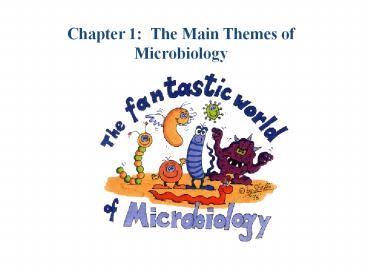Chapter 1: The Main Themes of Microbiology - PowerPoint PPT Presentation
Title:
Chapter 1: The Main Themes of Microbiology
Description:
Chapter 1: The Main Themes of Microbiology ... including other microorganisms Branches of Microbiology Agricultural microbiology Biotechnology Food, dairy, ... – PowerPoint PPT presentation
Number of Views:2401
Avg rating:3.0/5.0
Title: Chapter 1: The Main Themes of Microbiology
1
- Chapter 1 The Main Themes of Microbiology
2
- Microbiology is the study of living things too
small to be seen without magnification - Microorganisms or microbes- these microscopic
organisms - Commonly called germs, viruses, agents but not
all cause disease and many more are useful or
essential for human life
3
Major Groups of Microorganisms
- Bacteria, algae, protozoa, helminthes, and fungi
- Viruses- noncellular, protein-coated genetic
elements that can infect all living things,
including other microorganisms
4
Branches of Microbiology
- Agricultural microbiology
- Biotechnology
- Food, dairy, and aquatic microbiology
- Genetic engineering and recombinant DNA
technology - Public health microbiology and epidemiology
- Immunology
- Many, many more
5
The Impact of Microbes on Earth Small Organisms
with a Giant Effect
- Microorganisms have a profound influence on all
aspects of the earth and its residents - Bacterial-like organisms in the fossil record as
far back as 3.5 billion years ago (prokaryotes-
organisms without a true nucleus) - 2 billion years later, eukaryotes (organisms with
a true nucleus) emerged
6
Figure 1.1
7
Ubiquity of Microorganisms
- Found nearly everywhere!!
- Occur in large numbers
- Live in places many other organisms cannot
Figure 1.2
8
Microbial Involvement in Energy and Nutrient Flow
- Bacteria conducted photosynthesis before plants
appeared - Anoxygenic photosynthesis
- Oxygenic photosynthesis
- Biological decomposition and nutrient recycling
9
Human Use of Microorganisms
- Humans have been using microorganisms for
thousands of years - Bakers and brewers yeast
- Cheeses
- Moldy bread on wounds
Figure 1.3
10
Biotechnology and Bioremediation
- Biotechnology- when humans manipulate
microorganisms to make products in an industrial
setting - Genetic engineering- create new products and
genetically modified organisms (GMOs) - Recombinant DNA technology- allows microbes to be
engineered to synthesize desirable proteins (i.e.
drugs, hormones, and enzymes) - Bioremediation- introducing microbes in to the
environment to restore stability or clean up
toxic pollutants - Oil spills (recently seen with Gulf spill).
- Chemical spills
- Water and sewage treatment
11
Infectious Diseases and the Human Condition
- Pathogens- disease-causing organisms
- Opportunistic Pathogen
12
Figure 1.4
13
Worldwide Infectious Diseases
- Increasing number of emerging diseases (SARS,
AIDS, hepatitis C, viral encephalitis) - Other diseases previously not linked to
microorganisms now are (gastric ulcers, certain
cancers, schizophrenia, multiple sclerosis,
obsessive compulsive disorder, coronary artery
disease) - Increasing number of drug resistant strains
14
The General Characteristics of Microorganisms
- Cellular Organization
- Prokaryotic vs. eukaryotic cells
- Prokaryotic cells are about 10 times smaller than
eukaryotic cells - Prokaryotic cells lack many cell structures such
as organelles - All prokaryotes are microorganisms, but only some
eukaryotes are
15
Figure 1.5

